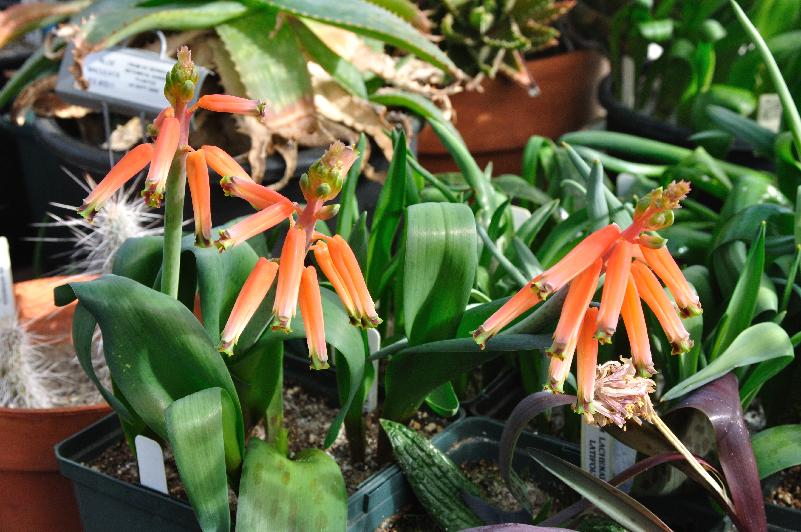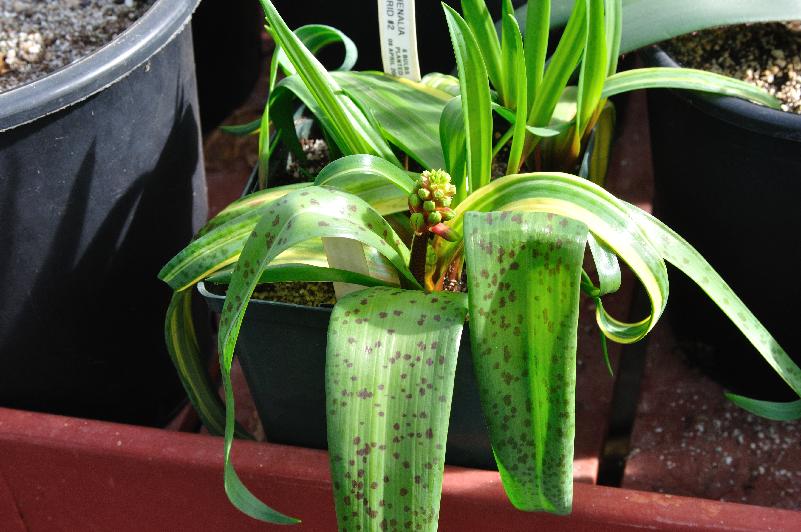Early Clivia miniata
The plant actually started to bloomed over two weeks ago, and is still in bloom. It went from the cool Clivia greenhouse to our cool entryway, so the flowers have stayed fresh a long time. The temperature in the greenhouse has been set at 50°F or 10°C for about two months now.
![Clivia [Foxy Lady x L-35] (c) copyright 2013 by James E. Shields. All rights reserved.](Clivia_FoxyLady_x_L35_Nr2656_1532_ml.jpg)
Clivia [Foxy Lady x L-35]
This hybrid came, as seed, from Felicity Weeden, in Hermanus, South Africa. Last year, this plant produced four scapes in succession. That is truly fantastic performance! I really like the pastel color with a hint of picotee as the flowers age. For me, this is a real keeper.
The only other clivias in bloom are a couple plants of Clivia robusta "Maxima" that came from Fred van Niekerk several years ago. To bring the miniata hybrids into scape, I will have to raise the temperature to 60-65°F roughly a month before I want to start seeing flowers in bloom.
Lachenalia
It is past time for the Lachenalia to have started blooming, but things are slow this year. I delayed watering until after we returned from Tanzania.

Lachenalia bulbifera
Graham Duncan changed some of the species names in his new book on the genus Lachenalia; I don't know what the newest names are, so I'll stick with the older ones.
There is also an unknown hybrid in bloom now that is big and robust. Unfortunately, the greenhouse got down to almost 25°F (ca. -04°C) this morning (a spider built a nest inside the thermostat in the last couple of days!) so it is still wilted. Fortunately, there are some other interesting hybrid Lachenalia among the bulbs my friend sent to me awhile back. This cross below shows up as a mixture, a couple of which are nicely variegated:

Lachenalia hybrid (my #2306)
This hybrid came from some nursery in South Africa, probably from the Western Cape province. A friend there hunted through several local nurseries for any unusual Lachenalia he could find for me. This is one of the results. I like the variegation, which also seems to have some spotting as well.
What is a Species?
This question is always good for an argument. The reason is that "species" is a human concept, made to satisfy our own desires for order in the world around us. Nature has not always obliged us with such orderly results. To make matters worse, human biologists have tried to define the concept for all living things, while nature seems to have taken three different approaches for animals, plants, and bacteria.
Animal species seem to be easy to pick out and tell apart. Animals hybridize much less often than plants, for instance, and the hybrids seem to usually be much less fertile that pure species. That may be why modern Europeans have only about 5% Neanderthal DNA in their genomes instead of perhaps 50%. Our remote grandparents hybridized with the weird Neanderthals they encountered when they moved into Europe from the Middle East ca. 50,000 years ago, but those babies grew up to have relatively few children, perhaps. We don't know yet, of course, about our great-great-great-etc. grandparents. About horses crossed with donkeys we do know. The male mules are never fertile, an occasional jenny mule will be fertile when back-crossed to one of the parent species.
Bacteria are chaos embodied, where genes are concerned. There is little morphology to go on -- round cells, rod-shaped cells, spiral cells. Smooth coats vs. rough coats, maybe? At any rate, we now know that there is rampant exchange of DNA between totally unrelated species of bacteria. It is no wonder that microbiologists have started giving new forms of bacteria serial numbers linked to their DNA sequences rather than genus and species names. In fact, biologists are finding new species of microorganisms based solely on the sequences determined for samples of DNA simply found in seawater. I would myself be afraid to use the term "species" when referring to any microorganism these days.
Plant species are sort of in between. They are usually not nearly so clear-cut as animal species, but they are one heck of a lot more distinctive than microbial species. This makes for good sport and bitter rivalries among plant taxonomists. The traditional morphologists and the new molecular geneticists sometimes have a tough time communicating with each other.
Some of the discussants in the Pacific Bulb Society on-line discussion group